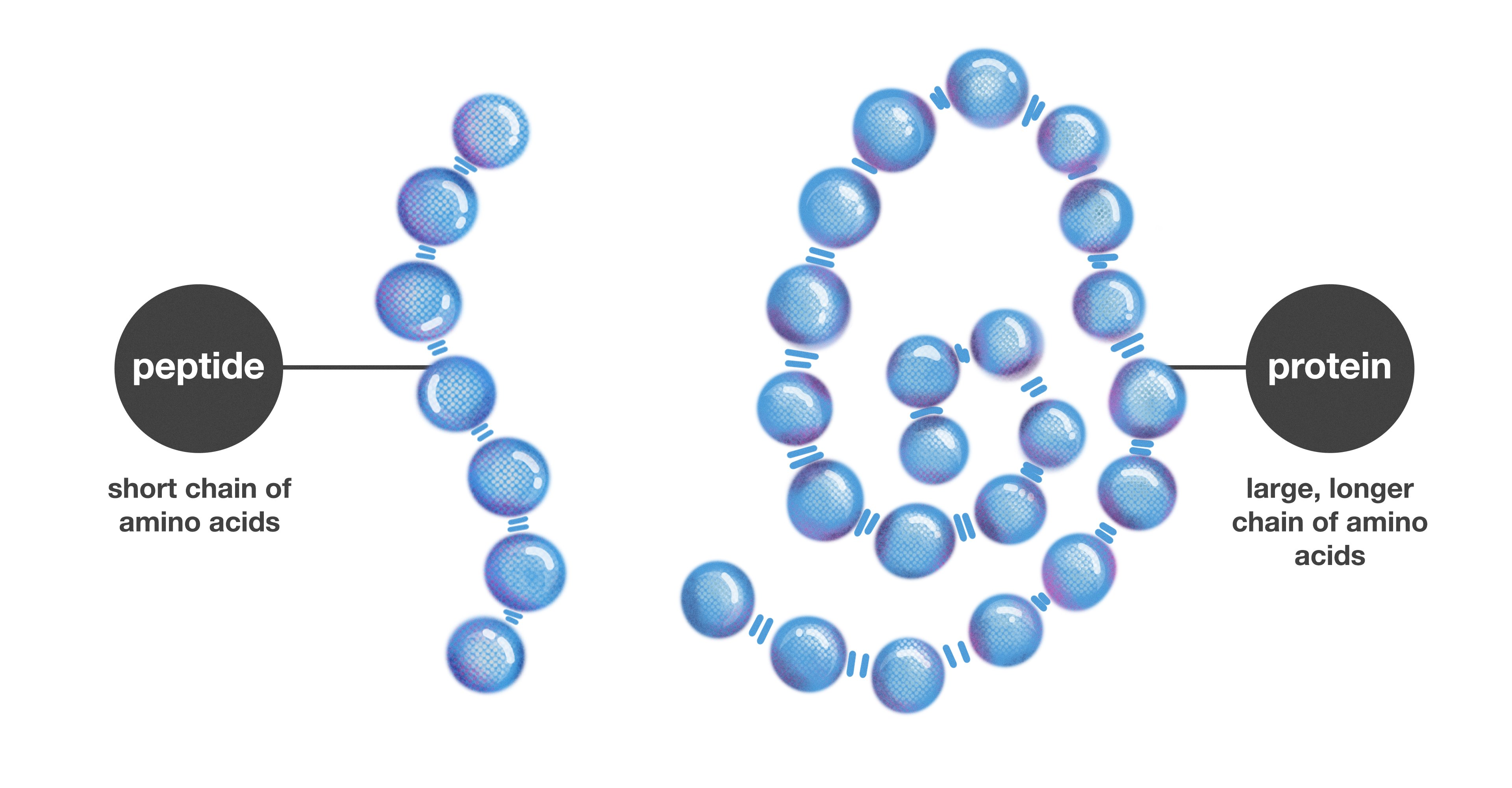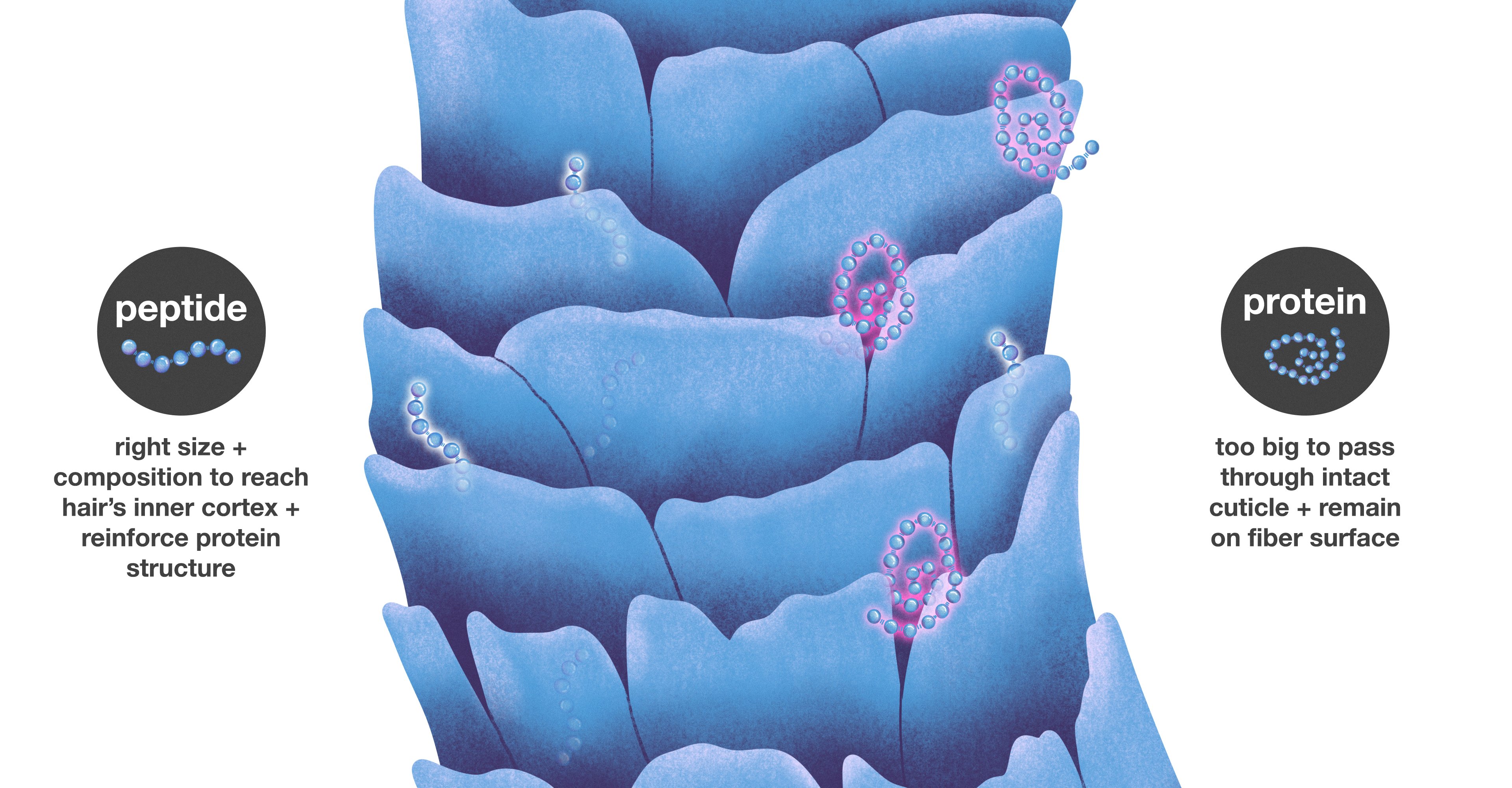People frequently ask us, “Is K18 a protein?” The answer is no. It’s a peptide.
But what’s the difference and why does this matter?
To explain, we’ll revisit the composition of hair, explore the difference between proteins and peptides, explain how protein treatments work, and how our K18PEPTIDE™ is different because it provides true molecular repair for hair damage at the deepest possible level. Discover how this unique biomimetic peptide is able to penetrate deep into hair to reconnect chemical bonds, unlike protein treatments that can build up on hair’s surface.
First, a quick refresher on the protein structure of hair.
your hair is mostly protein
The hair strand can be separated into two main layers—the outer cuticle and the inner cortex. The cuticle consists of shingle-like cells that protect your inner cortex from damage. The cortex is made up of interwoven chains of keratin proteins that assemble to form larger structures. There is a third layer in thicker hair called the medulla.
Your hair is made up of mostly proteins, including keratin. These proteins within the cortex provide your hair with its core strength and elasticity (read more about where hair strength comes from).
Many different types of chemical bonds exist and contribute to the overall protein structure of your hair, including ionic bonds, hydrogen bonds, disulfide bonds, peptide bonds, and hydrophobic interactions.
Your hair’s keratin chains are bound lengthwise by peptide bonds and crosslinked by disulfide bonds. These bonds can be broken by environmental factors like ultraviolet (UV) rays and pollutants, chemical services like perming or bleaching, heat from styling tools, and friction from daily brushing and styling. This is what we think of as hair damage.
proteins vs peptides: what’s the difference?
While both are made of amino acids—the basic building blocks of life—proteins and peptides have different molecular sizes and structures.
Peptides are smaller than proteins and are made up of 2 to 50 amino acids. In comparison, proteins contain more than 50 amino acids and can exceed 20,000 amino acids in size!

Because proteins are the foundation of your hair’s structure, many treatments, like leave-in and deep conditioners, include keratin or other proteins like collagen to strengthen hair on the surface level.
Our K18PEPTIDE™ is not a protein. It’s a peptide with a smaller molecular size that allows it to penetrate deep into hair’s core structure. Once inside hair’s innermost layers, it’s able to fit into and reconnect broken polypeptide chains responsible for hair strength and elasticity, unlike protein treatments that mainly fill gaps + cracks on the hair fiber surface and may either build or wash away.

how protein treatments work
Cosmetic formulations can contain full-sized or hydrolyzed proteins. Full-sized proteins are large molecules that have difficulty penetrating the hair strand and sit on the surface of the cuticle, acting as a shield and patching up any holes caused by damage. Hydrolyzed proteins are pieces of larger proteins that have been chemically broken up into smaller fragments composed of shorter chains of amino acids. These proteins can enter the cortex but are too short to provide true molecular repair and can only temporarily condition and moisturize your hair.
Another challenge with protein treatments is the perception that they can build up on the surface of your hair.
Protein buildup has been reported to weigh down hair, especially if your hair has a curly or coily texture. This buildup is temporary and can be treated, and too much protein won’t necessarily damage your hair.
It’s been suggested that overuse of protein-containing products can lead to “protein overload.” However, this phenomenon that supposedly leads to dry, brittle hair has not yet been observed in scientific literature.
Regardless, no need to worry about “protein overload” with K18, since K18PEPTIDE™ isn’t a protein.
Worried about buildup from other products? Cleansing with clarifying shampoo, keeping your ends trimmed, and using essential oils like peppermint, clary sage, and lavender oil can strip some of the excess protein buildup from your hair.
how the K18PEPTIDE™ works
Unlike large proteins that are limited to the surface of hair and can cause buildup, the K18PEPTIDE™ diffuses through the cuticle to provide holistic molecular repair, aka structural reinforcement, to the cortex, unlike hydrolyzed protein treatments.

Inside the cortex, our peptide can interact with the proteins in your hair, reconnecting the peptide and disulfide bonds that stabilize hair’s structure to repair damage and restore strength and elasticity.
Clearing buildup on the surface of hair from products or hard water will make it easier for the K18PEPTIDE™ to penetrate and repair hair. The K18PEPTIDE™ is also able to reach past the cuticle, so it doesn’t sit on the surface of hair and is not likely to cause buildup.
Less is more when applying the K18 mask thanks to its highly concentrated formulation. The K18-patented peptide’s size and amino acid sequence allow it to seamlessly fit into the holistic system of bonds in your hair, renewing hair strength, elasticity, smoothness, softness, and bounce—weightlessly.


